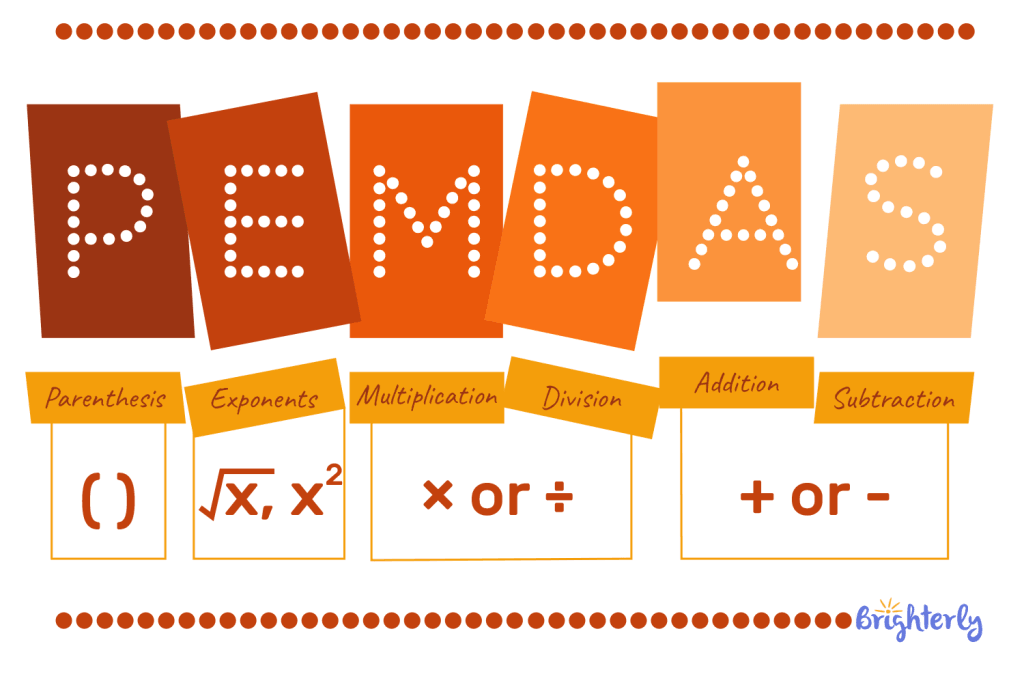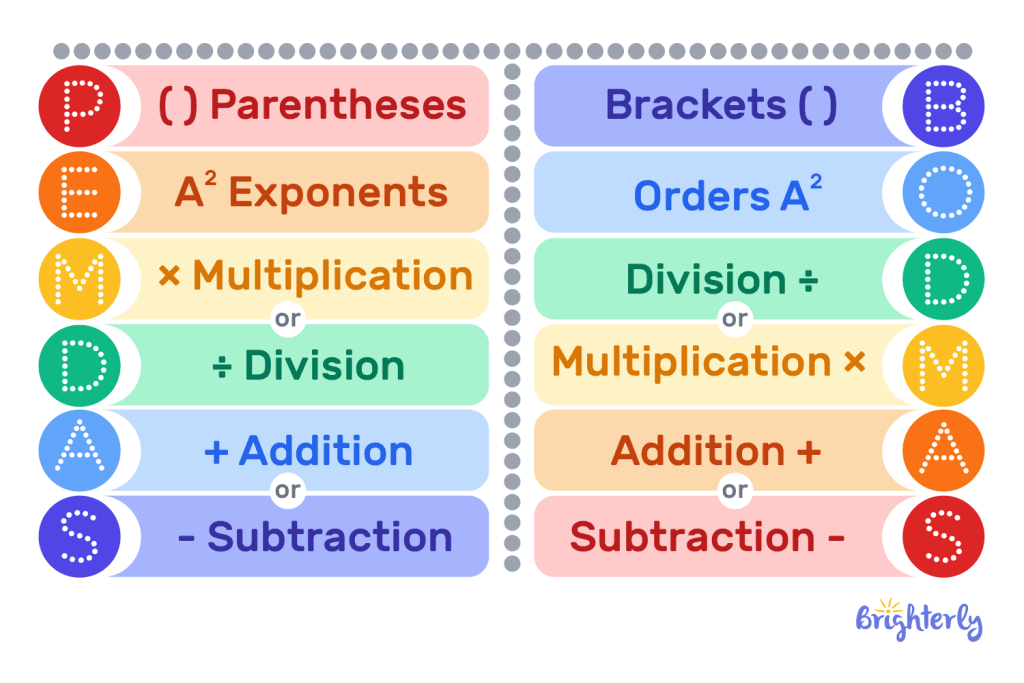PEMDAS Rule – Definition With Examples
Updated on November 28, 2025
It can be tricky to solve equations when there are many numbers and different operations involved. This is where the PEMDAS rules come in. By following our Brighterly easy guide, you will know which step to take first to get the right answer. It’s easy, clear, and even fun to solve equations using PEMDAS. We’ll break down each part of PEMDAS in this article and show you how to use it in everyday life with examples. The rules of PEMDAS in math stand for Parentheses, Exponents, Multiplication, Division, Addition, Subtraction.
What is the PEMDAS rule?
The rules of PEMDAS in math stand for Parentheses, Exponents, Multiplication, Division, Addition, and Subtraction.

Just as following traffic laws keeps you safe on the road, adhering to this rule guarantees that you always get the right answer when solving math problems.
Definition of the PEMDAS rule
Fundamentally, the math PEMDAS rule serves as a guide for solving equations in the right order. The operations enclosed in parentheses come first, followed by exponents (such as powers or square roots), multiplication and division (from left to right), and addition and subtraction (from left to right). Accurate problem solving requires knowledge of this order.
PEMDAS rule left to right
When using PEMDAS, it’s important to solve operations on the same level, like multiplication and division or addition and subtraction, from left to right. This means you do them in the order they appear, not all multiplication first and then all division. The same applies to addition and subtraction. Following this pemdas left to right rule helps to get correct answers and avoid mistakes.
PEMDAS rule vs Bodmas
Both PEMDAS and BODMAS impose a specific order of action to solve a math problem. BODMAS stands for Brackets, Orders, Division, Multiplication, Addition, Subtraction, while PEMDAS stands for Parentheses, Exponents, Multiplication, Division.

The phrase “Brackets” in place of “Parentheses” and “Orders” in place of “Exponents” is the primary distinction between the two. Thus, you can solve equations accurately and confidently by using either rule because they operate in the same way.
An explanation of each element in the rules of PEMDAS
Now let’s break each PEMDAS element further and so explore the rules of PEMDAS in math:
- Parentheses — Any computations enclosed in brackets should be completed first.
- Exponents — Next, solve square roots or powers.
- Division and multiplication should be done from left to right.
- Finish addition and subtraction last, working from left to right as well.
Properties of the PEMDAS rules
The PEMDAS order of operations rules help you get consistent and reliable results when solving expressions. Some operations are associative, meaning you can group the numbers in different ways without changing the outcome. They are also commutative, so changing the order of certain operations doesn’t affect the final answer. In addition, operations can be distributive, which means you can multiply first and then add or subtract, or do it the other way around, and you will still arrive at the same result.
Explanation of how the math rule PEMDAS is applied
Now, let’s explore how you can use the order of operations PEMDAS rules:
- Complete computations enclosed in Parenthesis.
- Take care of Exponents.
- Multiply and divide from left to right.
- Add and subtract from left to right.
Importance of the order in the PEMDAS rule
The PEMDAS order is vital because changing it will inevitably bring incorrect results. Operations that are finished too soon or out of order frequently result in errors.
Common mistakes when using the PEMDAS rule
Most mistakes occur when students ignore the PEMDAS rules for addition and subtraction. As for common cases, they can ignore parentheses, add or subtract too early, or assume that only one operation should be performed first. Some also forget to use multiplication and division from left to right, and the same goes for addition and subtraction.
Equations involving the rule of PEMDAS
Many math equations require the use of PEMDAS rules for correct solutions.
Let’s take the equation 4 + 2x(5 − 3)^2 to illustrate the PEMDAS rule example. According to the rule, we should first evaluate the parentheses (5 − 3), then the exponent (^2), then the multiplication (2 × 2), and finally the addition (4 + 4).
Writing equations using the PEMDAS rule
Kids can also create their own equations by following PEMDAS. First, they need to think about what operations they want to include — parentheses, exponents, multiplication, division, addition, or subtraction. Then they arrange these operations so the equation makes sense and can be solved step by step.
A kid might begin with a number and add parentheses to make the equation more engaging. Then add multiplication or division so that the order of operations matters. Following this rule helps them build correct equations and solve them without confusion.
Solving equations using the PEMDAS rule
Knowing the PEMDAS meaning and examples is vital when solving equations. For example, here’s a complex equation: 5+12÷4×2–3. To solve it, you can go through the following steps:
- Divide from left to right because they are on the same level. So, in 12 ÷ 4 × 2, start by dividing 12 by 4: 12 ÷ 4 = 3.
- Then do multiplication 3×2 = 6.
- And do addition and subtraction from left to right: 5+6-3 = 8.
Practice problems on the PEMDAS math rule
- 12+6×2 – 8÷4
- (5+3)x4 – 6^2÷3
- 20–2x(3 + 7)+8
- [(6 + 2)^2 ÷ 4] –5×2
Conclusion
Practicing the PEMDAS rule improves math skills and preparation. The rule shows the correct order for different calculations, helping students get the right answers. As students practice this rule, they develop strong calculation skills and are prepared for more difficult math problems.
Frequently asked questions on the PEMDAS rule
What are the rules of PEMDAS?
The rules for PEMDAS tell you the correct order required to solve math problems: Parentheses first, then Exponents, followed by Multiplication and Division (left to right), and finally Addition and Subtraction (left to right).
Why is the order important in the PEMDAS rule?
The order in PEMDAS is important because doing steps out of sequence can give the wrong answer. Following the correct order helps you solve multi-step equations accurately and consistently.
What are common mistakes made when using the PEMDAS rule?
The common mistakes made when using the PEMDAS rule include avoiding solving the equation from left to right, multiplying before dividing, and neglecting parentheses.
Can you provide some equations that require the PEMDAS rule?
Equations with more than one operation need the PEMDAS rule. For example:
- 3 + 2 × (4 − 1)
- (5² + 3) ÷ 4
How to use the PEMDAS rule to solve equations?
To use the PEMDAS rule to solve equations, you should first solve what’s in parentheses, followed by exponent calculations, then multiplication, division, and addition and subtraction from left to right.






